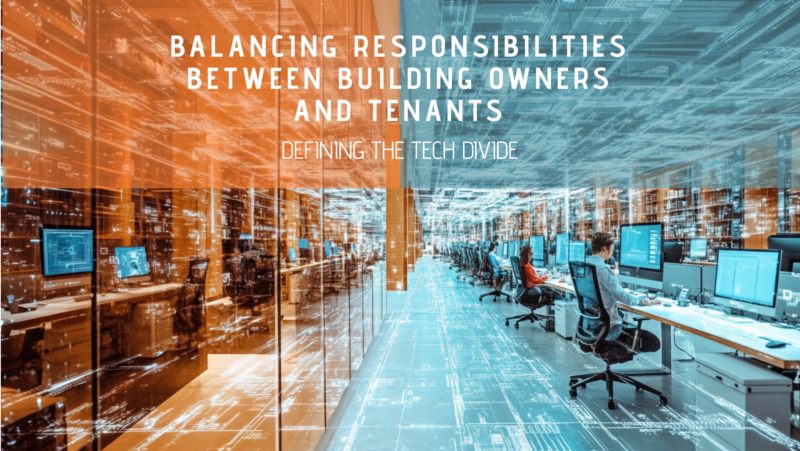
In the evolving landscape of commercial real estate, the intersection of technology and responsibility has become a critical focus. Commercial real estate’s relationship with technology is increasingly shaping how stakeholders approach these challenges. As buildings become smarter and more connected, the line between the roles of building owners and tenants in managing technology has blurred. It’s essential to clearly define these responsibilities to ensure that both parties can effectively contribute to a seamless and efficient environment. Building owners are increasingly tasked with providing robust infrastructure, while tenants are responsible for leveraging this technology to meet the specific needs of their end users.
In the evolving landscape of commercial real estate, the intersection of technology and responsibility has become a critical focus.
The Building Owner’s Role: Infrastructure and Operations
Building owners hold the crucial responsibility of providing the foundational infrastructure that supports the diverse needs of their tenants. This includes the implementation and maintenance of essential systems like HVAC, security, and connectivity—elements that form the backbone of a functional and efficient building environment.
A key challenge for building owners is to ensure that these systems are not only robust but also scalable and adaptable. As tenant needs evolve, the infrastructure must be flexible enough to accommodate new technologies and changing demands. For instance, as more tenants seek enhanced digital connectivity, building owners need to offer scalable network solutions that can support increased data loads without compromising performance.
“A building’s infrastructure should be a foundation that tenants can build upon, allowing them to customize and optimize their spaces to meet specific needs.”
By focusing on adaptable infrastructure, building owners can provide a versatile environment that empowers tenants to innovate and thrive. This approach not only enhances tenant satisfaction but also future-proofs the property, making it a more attractive option in a competitive market.
The Role of PropTech in Redefining Tenant Experience | Layer 10
The Tenant’s Role: Understanding and Serving the End User
Tenants occupy a unique position in commercial real estate, as they are closest to the end users—whether they are employees, customers, or clients. This proximity gives tenants valuable insights into the specific needs and preferences of the people using the space. By leveraging the building’s technology infrastructure, tenants can create customized solutions that enhance productivity and user satisfaction.
For example, a tenant might use the building’s scalable network infrastructure to implement a high-speed, secure Wi-Fi network tailored to their employees’ needs, ensuring seamless connectivity across all workstations. Similarly, tenants can utilize advanced HVAC systems to maintain optimal comfort levels, directly influencing employee well-being and productivity.
“Tenants are the bridge between the building’s infrastructure and the end user’s experience, making their role in optimizing the space crucial to overall satisfaction.”
By understanding their users and harnessing the building’s technological capabilities, tenants can transform their spaces into environments that not only meet but exceed expectations, ultimately driving success for their businesses.
Bridging the Gap: Collaboration Between Owners and Tenants
Effective communication and collaboration between building owners and tenants are essential for successful technology integration. When both parties clearly understand their roles and work together, the result is an optimized environment that benefits everyone. Owners can provide the necessary infrastructure, while tenants can tailor it to meet specific needs, leading to enhanced building performance and tenant satisfaction.
A successful example of this collaboration can be seen in buildings where owners and tenants co-create digital platforms for managing space usage and energy consumption. Another example is the use of tech solutions that help retail landlords find the right tenant mix, ensuring a balanced and synergistic environment for all stakeholders. These platforms allow tenants to monitor and adjust their energy use, while owners gain insights into overall building efficiency.
“Collaboration between owners and tenants is key to creating spaces that are not only functional but also adaptable to the changing needs of all users.”
By working together, owners and tenants can ensure that technology is implemented in a way that maximizes value and fosters a productive, satisfying environment for all.
The Future of Tenant Experience: Beyond Basic Amenities | Layer 10
Conclusion: Defining the Line for Success
Clear communication and responsibility-sharing between building owners and tenants are essential for successfully integrating technology in commercial properties. By defining the roles of each party—owners focusing on robust infrastructure and tenants on understanding and serving their end users—both can work together to create environments that are adaptable, efficient, and satisfying. This collaborative approach not only enhances building performance but also ensures that the needs of all stakeholders are met, ultimately leading to long-term success and tenant satisfaction.
At Layer 10, we understand the importance of clearly defining technology responsibilities between building owners and tenants. Our expertise positions us uniquely to work with both parties, ensuring that building infrastructure meets tenant needs while empowering tenants to create tailored experiences for their end users. Let’s collaborate to bridge the gap and maximize the potential of your commercial property.
Let’s build tomorrow, today.